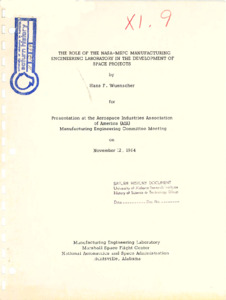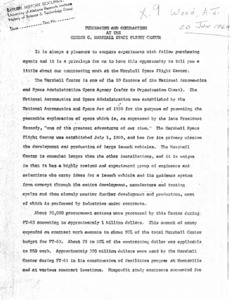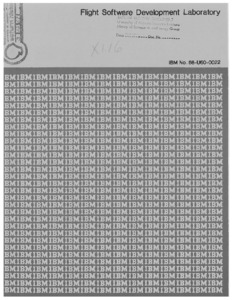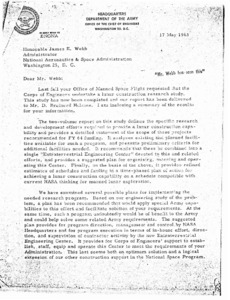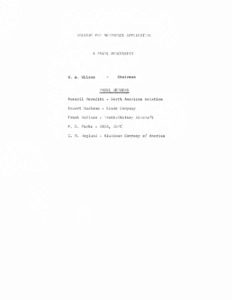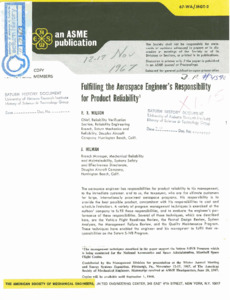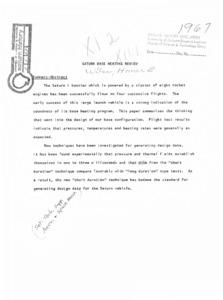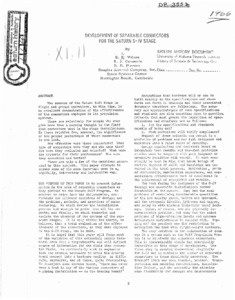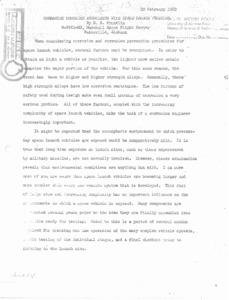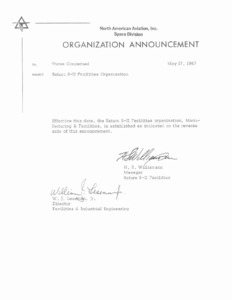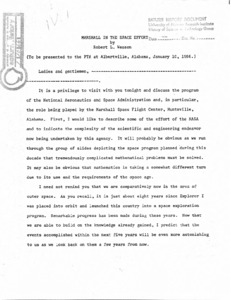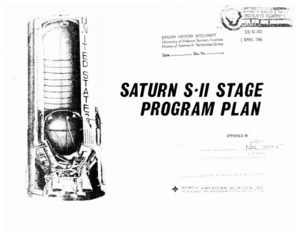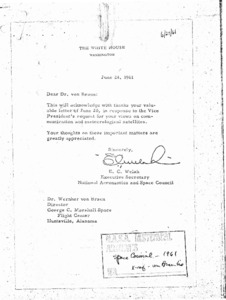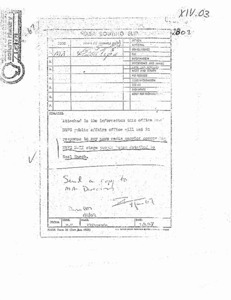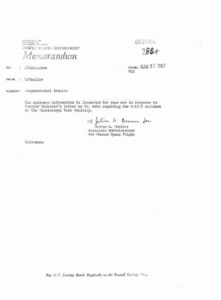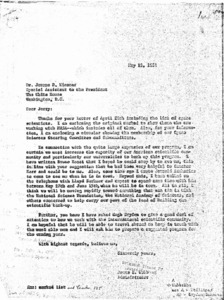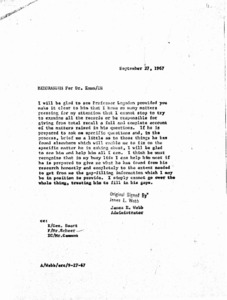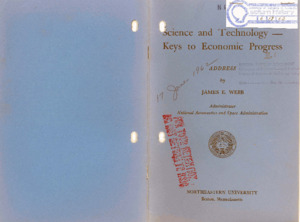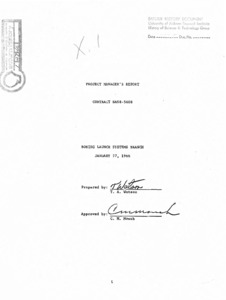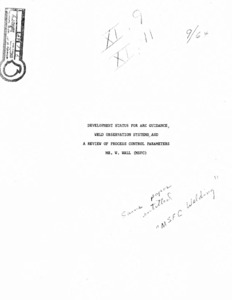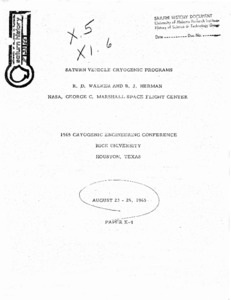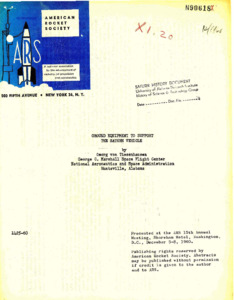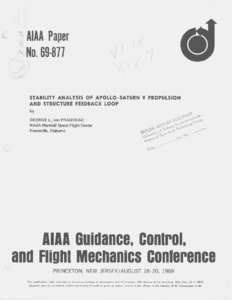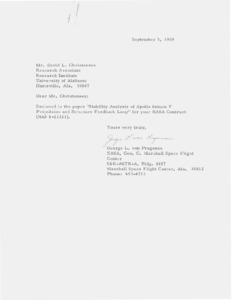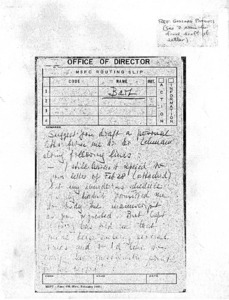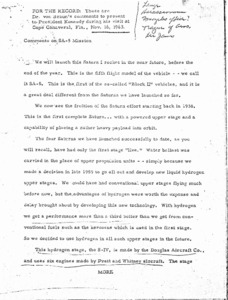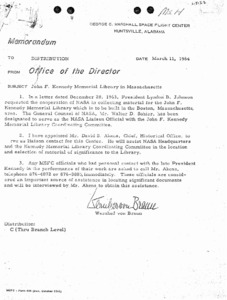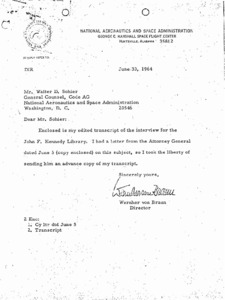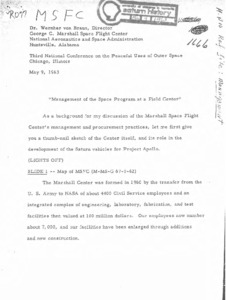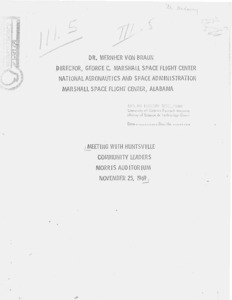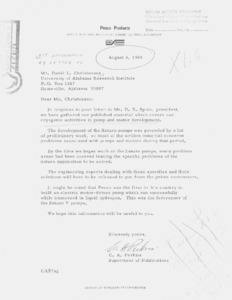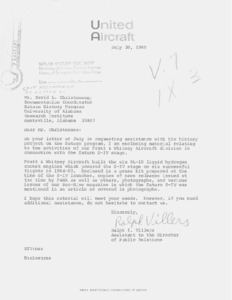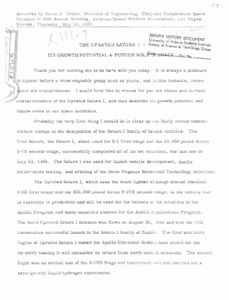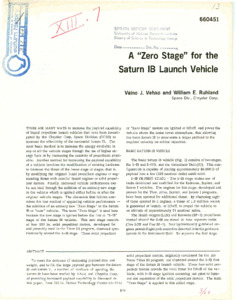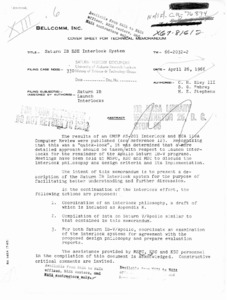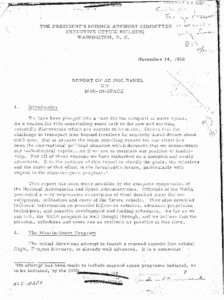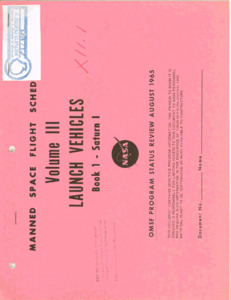
Browse Items (716 total)
Sort by:
-
"The role of the NASA-MSFC Manufacturing Engineering Laboratory in the development of space projects."
For presentation at the Aerospace Industries Association of America (AIA) Manufacturing Engineering Committee Meeting. Discusses the role the NASA Engineering Laboratory has had on NASA projects in the form of vehicles and smaller projects. -
"Purchasing and contracting at the George C. Marshall Space Flight Center."
This is a speech given to fellow purchasing agent regarding purchasing and contracting. -
"Flight Software Development Laboratory."
A man-in-the-loop computer facility has been created using a digital computer, display terminal,and space vehicle flight computer to enable programmers to check out flight programs in a simulated space flight environment. The simulation requires a real time multi-programmed environment, which is supplied by a control system capable of scheduling programs on 32 levels of priority interrupt as well as answering demands for service at the display terminal. A special interface device permits visibility and control of the flight program as it executes in the flight computer. On-line inputs from the programmer at the display terminal and outputs from data collection and reduction routines to the display screen are executed in real time. The Flight Software Development Laboratory has proved to be very useful in reducing program preparation time and increasing flight program confidence. -
Letter to Honorable James E. Webb, Administrator, National Aeronautics and Space Administration from W. K. Wilson, Jr.
Letter to James Webb from W. K. Wilson regarding one of his studies. -
"Welding for aerospace application : a panel discussion."
Original is a photocopy; W. A. Wilson, Chairman; Russell Meredith, North American Aviation; Robert Hackman, Linde Company; Frank Wallace, Pratt-Whitney Aircraft; P.G. Parks, NASA, MSFC; G. O. Hoglund, Aluminum Company of America. -
"Fulfilling the Aerospace Engineer's Responsibility for Product Reliability."
The management techniques described in the paper support the Saturn S-IVB Program which is being conducted for the National Aeronautics and Space Administration, Marshall Space Flight Center. -
"Saturn base heating review."
The Saturn I booster which is powered by a cluster of eight rocket engines has been successfully flown on four successive flights. The early success of this large launch vehicle is a strong indication of the soundness of its base heating program. This paper summarizes the thinking that went into the design of our base configuration. Flight test results indicate that pressures, temperatures and heating rates were generally as expected. New techniques have been investigated for generating design data. It has been found experimentally that pressure and thermal fields establish themselves in one to three milliseconds and that data from the "short duration" technique compare favorably with "long duration" type tests. As a result, the new "short duration" technique has become the standard for generating design data for the Saturn vehicle. -
"Development of Separable Connectors for the Saturn S-IV Stage."
The purpose of this paper is to present information, in the area of separable connectors as they pertain to the Saturn S-IV Program. -
"Corrosion problems associated with the Saturn space vehicles."
Corrosion problems associated with space vehicles, in general, are discussed as contrasted to those problems experienced with structures in an earth atmosphere. Primary emphasis is placed on structural alloys in this discussion, although some corrosion failures experienced in various mechanical components are described. General corrosion prevention measures are indicated, and solutions to specific corrosion failures described. Major failures experienced have been attributed to stress corrosion cracking, rather than general or galvanic type corrosion. Most such failures have occurred with only five different materials: three aluminum alloys - 7075-T6, 7079-T6, and 2024-T6; and two precipitation hardening stainless steels - 17-7PH and AM 355. Corrective actions were different in each case, but involved either a complete change to another material, a change to a different temper of the same alloy, or a modification of the heat treatment and/or general processing techniques. General conclusions are that the types of failures described could be avoided by: a more suitable selection of alloys in the initial design, a realistic review of the environments that could be encountered in the service lifetime of the component, lowering stresses, improving process controls, and effecting better familiarization of design personnel with the with the overall stress corrosion problem in an effort to reduce human error.; Preprint 18e.; Materials for re-entry and spacecraft systems - spacecraft materials.; Materials Conference, Philadelphia, Pennsylvania, March 31 - April 4, 1968. -
"Saturn S-II facilities organization."
Organizational chart for the Saturn II facilities. -
"Marshall in the Space Effort."
Presentation reviewing the complex engineering undertaken at NASA and the mathmatical problems that need to be solved regarding the space program. -
"Saturn S-II stage program plan."
This documents outlines the S & ID plan to fulfill the requirements of Contracts NAS7-80 and NAS7-200 for the design, development and manufacture of the Saturn S-II stage.; APPROVED by R E. Greer, Vice President and S-II Program Manager.; This reissue supersedes all previous issues of this report.; FOREWORD: The S-II stage is 81.5 feet in length and 33 feet in diameter, with a usable propellant capacity of 970,000 pounds, The S-II propellants are fully cryogenic-liquid oxygen at -279 F and liquid hydrogen at -423 F. Its five-engine cluster provides one million pounds of thrust. The stage is a cylindrical structure of relatively light weight with a shell designed to resist all loads without the use of stiffening members. Its skin is of welded aluminum panels, as are the elliptical bulkheads of the fuel and oxidizer tanks. Unique to its design is the common bulkhead that separates the -423 F liquid hydrogen from the -247 F liquid oxygen. The common bulkhead - a sandwich of two 33-foot diameter aluminum domes separated by an insulating filler of honeycomb - eliminates the weight penalty that would be imposed by the second bulkhead in more conventional design. This document describes the S & ID program plan for development of the S-II stage and associated a support equipment. -
"Letter to Professor John M. Logsdon."
Letter to Professor Logsdon from E. C. Welcsh denying Logsdon's request to quote Wernher von Braun and President Kennedy from their memorandums. -
"Letter to Dr. Wernher von Braun."
Letter to Wernher von Braun from E.C. Welsch thanking Braun for his letter on June 20th regarding his thoughts on communication and meteorological satilites. -
"Letter to Professor John M. Logsdon."
Correspondance between Professor Logsdon and Welsh regarding Logsdon quoting Wernher von Braun's memorandum. -
"Response to any news media queries concerning MSFC S-II stage."
Letter to answer any incoming questions from the media regarding the MSFC-II stage and any briefed on Seal Beach. -
Congressional inquiry regarding the S-II-T accident at the Mississippi Test Facility : letter to the honorable Clinton P. Anderson, Committee on Aeronautical and Space Science, United States Senate from James E. Webb, Administrator.
Archive copy is a photocopy.; Includes memorandum and information from George E. Mueller, Associate Administrator for Manned Space Flight. Letter contains handwritten editing and notes. -
"Letter to Dr. Jerome B. Wiesner."
Letter to Jerome B. Wiesner from Jones B. Webb regarding requested documents as well as how they, as scientists, interact with the scientific community. -
"Memorandum for Dr. Emme/EH from James E. Webb, Administrator."
Memorandum regarding a potential meeting between James E. Webb and Professor Lagadon. -
"Science and technology - keys to economic progress."
A book written with the key focus being how technology and science and its progress can aid in the growth of the economy. -
"Project Manager's Report."
Report detailing the costs of materials and contracts. -
"Development Status for Arc Guidance, Weld Observation Systems, and a Review of Process Control Parameters."
Letter to David L. Christiensen from W. A. Wall, enclosing requested documents. -
"Saturn Vehicle Cryogenic Programs."
Paper from the 1965 Cryogenic Engineering Conference at Rice University, Houston, Texas, paper K-4. The abstract states, "This paper covers the cryogenic propellant and gaseous application to the George C. Marshall Space Flight Center Saturn Programs. Emphasis is placed on the overall application and the resultant logistic considerations. The planning of facilities, storage, and transportation required to ensure an adequate supply of cryogenic fluids when needed is traced from the engine and stage requirements. The entire cycle of technical requirements, estimating the quantities required from production and management of the program is developed, spacecraft application and other trends that affect cryogenic production are reviewed." -
"Ground Equipment to Support the Saturn Vehicle."
With the advent of the first large space vehicle, the SATURN, the ground support equipment and launch facility designer is faced with the necessity of conceiving and building an unprecedented launch system concurrent with the vehicle development. The paper intends to present a comprehensive picture of the problems involved and how they are solved. It follows the SATURN through the various modes of operation such as transportation over land and water, checkout, handling and erection, propellant loading, and describes the facilities at the launch site. -
"Stability analysis of Apollo - Saturn V propulsion and Structure feedback loop."
The propulsion and the structure of a space vehicle form a feedback loop through inertial coupling referred to as the pogo phenomenon and experienced with the Thor , Titan, and Apollo-Saturn V space vehicles. -
"Letter to Mr. David L. Christensen."
Letter to David L. Christensen from Ralph I. Villers responding to a request from Christiansen. Enclosed is the material requested. -
"Goddard patents: notes from von Braun to Slattery."
Archive copy is a poor photocopy.; Handwritten in ink is: Ref: Goddard Patents (See D. Akens for final draft of letter). -
Comments on SA-5 mission.
A notation in the upper lefthand corner states "For the record: These are Dr. von Braun's comments to present to President Kennedy during his visit at Cape Canaveral, Fla., Nov. 16, 1963." A handwritten note is in the upper right corner. It appears that some of the pages to this document are missing. -
"Memorandum: John F. Kennedy Memorial Library in Massachusetts."
Memorandum from Wernher von Braun regarding a request made for NASA's cooperation to obtain resources from the Kennedy Memorial Library. -
"Letter to Mr. Walter D. Sohier."
This letter was attached to the edited transcript of the interview for the John F. Kennedy Library.; Archive copy is a photocopy. -
"Management of the Space Program at a Field Center."
Transcription of a presentation from Wernher von Braun discussing the roles of the space vehicles in the Apollo project. -
"Letter to the Vice President of the United States and White House."
This is an attempt to answer some of the questions about our national space program raised by The President in his memorandum to you dated April 20, 1961. I should like to emphasize that the following comments are strictly my own and do not necessarily reflect the official position of the National Aeronautics and Space Administration in which I have the honor to serve. -
"Meeting with Huntsville community leaders, Morris Auditorium."
Transcription of a conversation with Wernher von Braun. -
Letter to Mr. David L. Christensen.
Letter from C.A. Perkins to David L. Christensen regarding a request for information regarding cryogenic pump and motor development -
"Letter to Mr. David Christensen."
Letter to David L. Christensen from Ralph I. Villers responding to a request from Christiansen. Enclosed is the material requested. -
"The uprated Saturn I - its growth potential & future role in space."
Remarks by Vaino J. Vehko, Director of Engineering, Chrysler Corporation Space Division at 30th Annual Meeting, Aviation/Space Writers Association, Las Vegas, Nevada -
"A 'Zero Stage' for the Saturn IB Launch Vehicle."
To meet the demands of increasing payload size and weight, and to fill the large payload gap between the Saturn IB and Saturn V, a number of methods of uprating the Saturn IB have been studied by NASA and Chrysler Corp. of providing increased payload capability is discussed in this paper. Four 120 in. United Technology Center UA-1205 solid propellant motors, originally developed for the Air Force Titan III program, are clustered around the S-IB first stage of the Saturn IB launch vehicle. These four solid propellant motors provide the total thrust for liftoff of the vehicle, with S-IB stage ignition occurring just prior to burn-out and separation of the solid propellant motors. The term "Zero Stage" is applied to this added stage. -
"Saturn IB ESE interlock system."
The results of an OMSF AS-201 Interlock and RCA 110A Computer Review were published. Recognizing that this was a "quick look", it was determined that a more detailed approach should be taken with respect to interlocks for the duration of the Saturn IB-V program. -
"Report of Ad Hoc panel on Man-in-Space."
It is the purpose of this report to clarify the goals, the missions and the costs of this effort in the forseeable future, particularly with regard to the man-in-space program -
"Manned space flight schedules. Vol. III, launch vehicles : book 1, Saturn I."
OMSF Program Status Review August 1965.; Edition "A"
